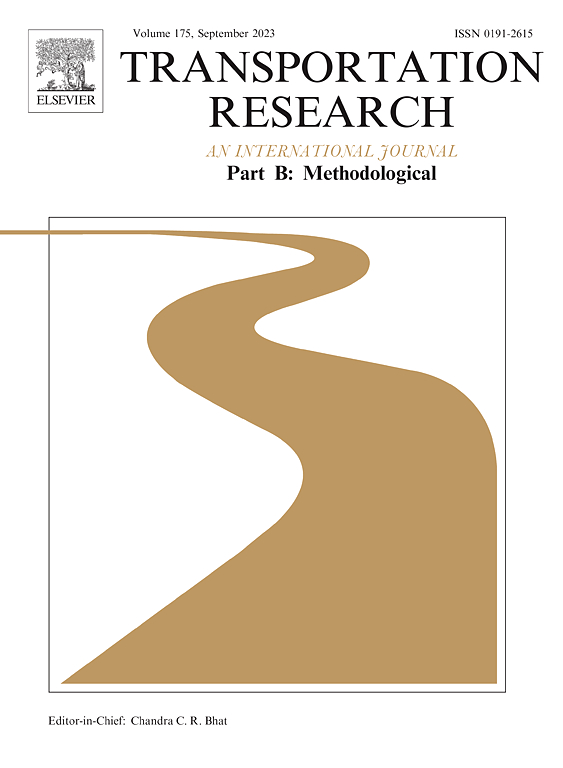交通基础设施适应的政府说服策略:溢出效应和社会福利影响
IF 6.3
1区 工程技术
Q1 ECONOMICS
引用次数: 0
摘要
本文探讨了政府说服多家交通设施运营商承担适应项目的策略,特别是在亚洲主义治理机制下,政府对设施运营施加重大影响。我们建立了贝叶斯说服模型来分析这些策略,重点关注运营商项目之间的溢出效应及其对社会福利的外部性(积极和消极)。我们的研究结果表明,直接建议运营商是否投资的直接信号策略可以有效地传达灾害信息。在不存在溢出效应且适应项目对社会福利产生积极影响的情况下,政府应充分披露灾害信息,并根据经营者的投资意愿说服其投资。然而,更高的适应成本或更大的溢出效应使政府的说服努力复杂化。为了证明理论框架的实用价值,我们将贝叶斯说服模型应用于中国大湾区港口适应案例。模型校准结果表明,当经营者独立行动时,更大的溢出效应可能导致更高或更低的社会福利,这取决于适应项目的正面或负面影响。当适应项目对社会福利产生正向影响时,运营商联合适应投资或资源共享的联盟策略可提高社会福利。如果运营商之间存在溢出效应,基于Shapley值的利益分配方案可以在所有运营商的大联盟内保持稳定。最后,不断增加的适应成本对不同运营商的影响不均衡,成本最高的运营商更有可能被排除在政府的说服努力之外。本文章由计算机程序翻译,如有差异,请以英文原文为准。
Government persuasion strategies for transport infrastructure adaptation: Spillover effects and social welfare impacts
This paper explores the government's strategies to persuade multiple transport facility operators to undertake adaptation projects, particularly within the Asian doctrine governance regime, where the government exerts significant influence over facility operations. We develop a Bayesian persuasion model to analyze these strategies, focusing on the spillover effects among operators' projects and their externalities (both positive and negative) on social welfare. Our findings suggest that a straightforward signaling strategy, which directly advises operators on whether to invest, can effectively convey disaster information. When there are no spillover effects and the adaptation projects positively impact social welfare, the government should fully disclose disaster information and persuade operators based on their willingness to invest. However, higher adaptation costs or larger spillover effects complicate the government's persuasion efforts. To demonstrate the practical value of our theoretical framework, we apply our Bayesian persuasion model to the case of port adaptation in the Greater Bay Area in China. The model calibration results indicate that when operators act independently, larger spillover effects can lead to either lower or higher social welfare, depending on whether the adaptation projects have positive or negative impacts, respectively. When adaptation projects positively affect social welfare, operators' alliance strategies of joint adaptation investment or resource sharing enhance social welfare. If spillover effects exist among operators, a benefit distribution scheme based on the Shapley value can maintain stability within the grand coalition of all operators. Finally, increasing adaptation costs have uneven impacts on different operators, with those facing the highest costs being more likely to be excluded from the government's persuasion efforts.
求助全文
通过发布文献求助,成功后即可免费获取论文全文。
去求助
来源期刊
CiteScore
12.40
自引率
8.80%
发文量
143
审稿时长
14.1 weeks
期刊介绍:
Transportation Research: Part B publishes papers on all methodological aspects of the subject, particularly those that require mathematical analysis. The general theme of the journal is the development and solution of problems that are adequately motivated to deal with important aspects of the design and/or analysis of transportation systems. Areas covered include: traffic flow; design and analysis of transportation networks; control and scheduling; optimization; queuing theory; logistics; supply chains; development and application of statistical, econometric and mathematical models to address transportation problems; cost models; pricing and/or investment; traveler or shipper behavior; cost-benefit methodologies.

 求助内容:
求助内容: 应助结果提醒方式:
应助结果提醒方式:


